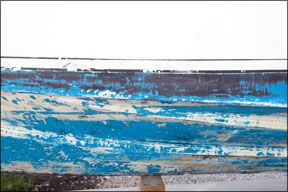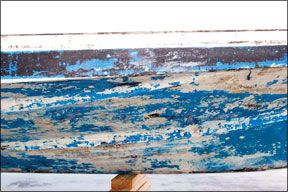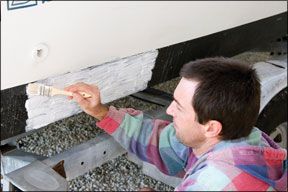Getting old paint off your boat is not a fun job, no matter how you do it. And it turns downright ugly when you have to remove a couple decades worth of bottom paint. But that is just what we did in the head-to-head paint stripper test our readers demanded.

Our last test of paint strippers, published in the November 2006 issue, saw Franmar Soy Strip edge out perennial favorite Peel Away Marine Safety Strip to become the Practical Sailor Best Choice. After that review, we heard from several Practical Sailor subscribers who reported less-than-stellar results from the Franmar Soy Strip. Conversations with the readers and manufacturers suggested that performance is greatly affected by ambient temperature. This convinced us of the need to retest the Franmar in cooler conditions than those of the 2006 test (a humid, 85-degree Virginia day).
Reader reports also alerted us to a new paint remover from Peel Away maker Dumond Chemicals Inc. Manufactured as a private-labeled product, West Marine Paint Remover was released after our last test and so has not been in Practical Sailor tests before. (We also learned from Dumond that Peel Away Marine Safety Strip is no longer available.)
And so it was that testers decided on a test between the 2006 favorite Franmar and the eco-friendly West Marine newbie. For this update, temperatures ranged from the mid-60s to the mid-70s. Not cold, but significantly cooler than the 2006 tests 85 degrees.
How We Tested
Dumond Chemicals supplied us with several gallons of the West Marine for testing. Franmar supplied us with several gallons of Marine Soy Strip and a final cleanup solution.
We removed bottom paint from a 34-year-old, 20-foot Seacraft powerboat. The transom on this boat had recently been restored. During the restoration, a single coat of bottom paint was applied over the new gelcoat to match the remainder of the hulls bottom paint lines.

This afforded us the opportunity to test each paint remover on a single coat of bottom paint on the transom and on decades of bottom paint build-up on the rest of the hull. We don’t know exactly how many layers or what type of bottom paint was on this boat, but we could see several colors and estimated at least five layers of bottom paint on the hull. The facts that the boat is trailerable and at least some previous owners stored it on the trailer lead us to believe that most of bottom paint is “hard” type paint.
Adding difficulty to an already ugly job, the boats most recent owner had applied a plastic-tape accent stripe just above the original painted waterline. Then, unfortunately for testers, he had this stripe and the rest of the bottom covered with yet another layer of bottom paint.
We conducted our testing over three days. The morning air temperature on Day 1 was 62 degrees, and by late afternoon, it had heated to 72 degrees. Temperatures on the remaining two days were in the mid-70s.
On Day 1, we applied both strippers in accordance with the instructions to a 1-foot by 2-foot test area on each side of the hull, Franmar on the port and West on the starboard. Next, we started at the bow and applied the Franmar down to the centerline and back to the transom. This took about 30 minutes. Then we did the same with the West Marine Paint Remover on the opposite side.
Once the test strips were about an hour old, we scraped a small section of each one to check results. We continued to scrape a small section of the test strips every hour for the following six hours to see whether an increasing amount of paint was being removed. Finally, we coated half the transom with each product. Testers let the products sit (dwell) for six hours on Day 1.
On Day 2, we skipped the test patches and transom application, but otherwise the strippers were each applied in the same manner as Day 1. Again, total dwell time was about six hours. Day 2 was windy, causing some drying out of the strippers.
After our Day 2 results were in, we decided to call both product manufacturers to see whether they had any advice or opinions on our results thus far. As a result of these conversations, testers opted for one more day of testing.
On Day 3, we applied each product as before, but then we covered the products with a .5-mil layer of plastic to prevent the stripper from drying out during our planned 14-hour overnight dwell time.
When all work was complete, we pressure-washed the hull to remove any residual stripper or loose paint. About 3 gallons of each product was required to remove all the paint from each side of the hull. Total bill, without labor, would have been about $450. Not cheap, but better than grinding in our view.
Franmar Soy Strip

Testers found applying the Franmar Soy Strip to the relatively small hull to be easy. Using a four-inch paintbrush, testers were able to easily control the amount of product applied.
As we scraped the Franmar test area hourly on Day 1, testers noticed a progressive increase in the amount of old paint being removed from the first to the second hour. After that, however, the amount of paint removed did not seem to increase.
Things worked a little faster on the transom. After about one hour, scraping the Franmar-coated section took off about 90 percent of the single-coat paint. Following the Soy Strip directions and tip sheet, testers followed the paint removal with a freshwater scrub/rinse and then removed the small amount of residual paint by wiping the transom with Ickee Stickee Unstuck, another Franmar product. This left the Franmar side about 99 percent clean.
For removing only one coat of paint, testers rated the Franmar Soy Strips performance as Excellent.
We began to strip the remainder of the hull after about a five-hour dwell time. Once scraping was completed, we estimated that only 40 percent of the paint had been removed.
On Day 2, after about six hours of dwell time, the Soy Strip removed more paint-about 10 percent more by our estimation. We consulted Franmars Jason Davenport. He suggested that we reapply, allow a longer dwell time, and cover the stripper with a layer of plastic.
Following our late afternoon application and covering, we returned to scrape early the following morning, after about 14 hours had passed. About another 20 percent came off.
Bottom Line:
The Soy Strip worked great on a single coat of paint. When it came time to remove multiple layers, the environmentally friendly product struggled and ate away slightly less than the West Marine stripper.
West Marine Marine Paint Remover
Dumond Chemicals Inc. makes this new product for marine retail giant West Marine. A rebranded version of Dumonds Peel Away Smart Strip, the water-based West Marines Marine Paint Remover is biodegradable and free of harmful volatile organic compounds (VOCs). Unlike other Peel Away products weve tested, no laminated paper is required with the Smart Strip or the West Marine Paint Remover, but it can accelerate the paint removal.
Our testers found the West Marine Paint Remover to be a tad more difficult to apply than the Franmar Soy Strip. But it was still fairly easy to get the appropriate cover with our 4-inch brush. Testers rated the West Marine application as Good.
On testing Day 1, the West Marine test seemed to reach its peak of removed paint after about two hours. Beyond that, there was no noticeable increase in paint being removed.
On the transom, the West Marine coating appeared ready for removal at about the 90-minute mark. Scraping left the section about 90 percent clean. We followed this up with a mineral spirit scrub/rinse to get the residual paint off. We estimated that the West Marine Paint Remover and follow-up removed 99 percent of the bottom paint from the transom. This certainly qualifies as an Excellent performance.
We began to strip the remainder of the hull after about four hours because large sections of stripper were beginning to literally fall off the bottom of the boat. With scraping completed, about 50 percent of the caked-on bottom paint had been removed, just slightly better than the Franmar. Testers also found scraping the West to be easier than scraping the Franmar.
On Day 2, the West Marine stripper removed another 15 percent of the bottom paint. At this point, we decided to talk to Dumonds Barry Dubin. As with the Franmar advice, Dubin suggested we increase the dwell time and cover the product with plastic. He said that normally, the dwell time for a multi-layer removal would be between six and 12 hours. He also told us that once the stripper begins to loosen and fall off, as ours did on Day 1, it is wise to begin scrapping as no further stripping action is occurring.
Day 3 results with the West Marine Paint Remover were slightly better than with the Franmar. Testers estimated that it took off another 15 percent of the total paint.
Bottom Line:
This did excellent where paint was only one-coat thick. The West Marine also had difficulty removing multiple layers, but it took off a tad more than Franmar.
Conclusions
Bottom paint removal is a nasty business. Neither product did what wed consider a fantastic job on the toughest work. But the West Marine Paint Remover did remove a bit more paint, giving it a slight edge over the Soy Strip for our top pick in this test. The Franmar works well and is easier to apply. It holds a spot as a Recommended paint remover.

































